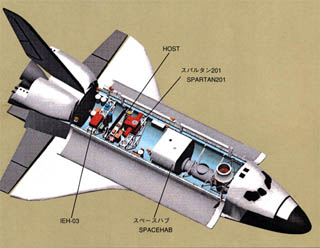| Mission Overview |
 |

Layout of payloads on STS-95 |
STS-95 is a National Aeronautics and Space Administration (NASA) Space
Shuttle Mission. Mission activities will include life science and microgravity
experiments to be conducted jointly by NASA, National Space Development
Agency of Japan (NASDA), the European Space Agency (ESA) and the Canadian
Space Agency (CSA), deploy and retrieval of a solar observation satellite
"Spartan," evaluation of a new orbital replacement unit to be
installed in the Hubble Space Telescope, and astronomical observation using
the International Extreme Ultraviolet Hitchhiker-03.
During the STS-95 mission, Astronaut Mukai performs life science and space
medicine experiments. This is her second flight since the Second International
Microgravity Laboratory (IML-2) mission in 1994.
The 77-year-old Senator John Glenn also boards STS-95. His first venture
into space was the Mercury Project 36 years ago in 1962.
| STS Mission No. |
STS-95 |
| Launch Date |
October 29, 1998 2:19 p.m. (EST)
October 30, 1998 4:19 a.m. (JST) |
| Launch Site |
NASA Kennedy Space Center |
| Mission Duration |
approx. 8 days, 21 hours 45 minutes |
| Orbiter |
Discovery (25th flight) |
| Altitude |
approx. 555 km (300 nautical miles) |
| Inclination |
approx. 28.5 degrees |
| Landing Date |
November 7, 1998 12:04 p.m. (EST)
November 8, 1998 2:04 a.m. (JST) |
| Landing Site |
NASA Kennedy Space Center |
| Last Updated: November 10,1999 |

|
